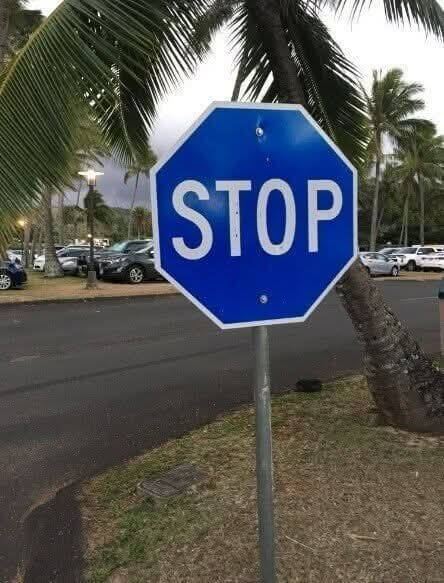Every driver knows the classic red, octagonal stop sign—it’s one of the most recognizable symbols in the world. That bold red background with white letters isn’t just for style. It’s designed for maximum visibility in all weather and is psychologically linked to urgency and stopping. The Manual on Uniform Traffic Control Devices (MUTCD) mandates red for this reason, making it the perfect choice for such an important command.
But what happens when you see a blue stop sign? It’s enough to make any driver pause in confusion.
🔵 What’s the Story Behind Blue Stop Signs?
Yes, blue stop signs exist, but they’re not part of the official federal traffic system and are never used on public roads. Instead, you’ll find them in places like:
- Gated communities
- University campuses
- Business complexes
- Private parking lots
On private property, traffic signs don’t have to follow the same rules as public streets. Property owners can install custom signs, including blue stop signs, to control traffic flow and enhance safety. However, unlike standard red signs, they don’t carry the same legal weight.
🎨 Why Traffic Sign Colors Matter
Every traffic sign color has a specific meaning:
- Red: Stop or prohibition
- Yellow: Warning or caution
- Green: Directional guidance
- Blue: Information (rest areas, services)
-
Black/White: Regulations (speed limits)
A blue stop sign breaks the usual color code. Since blue typically means “informational” rather than “command,” it can create hesitation for drivers who instinctively expect red. That brief hesitation could be risky in busy areas.
🚗 Should You Stop for a Blue Stop Sign?
Yes—always. Even though a blue stop sign may not be legally enforceable on public roads, ignoring it can still cause problems on private property, including:
- Collisions or close calls
- Breaking community or property rules
- Endangering pedestrians and other drivers
✅ Best Practice: Stop Every Time
Whenever you see a stop sign—regardless of color—follow these steps:
- Come to a complete stop
- Check for other vehicles and pedestrians
- Continue only when it’s safe
A blue stop sign might look unconventional, but its message is still clear: slow down, stop, and keep everyone safe.
💬 Have you ever spotted a blue stop sign and wondered why it was there? Share this with friends and family so they know exactly what to do when they see one. Safety on the road isn’t just about the color—it’s about the choice to protect yourself and others.
